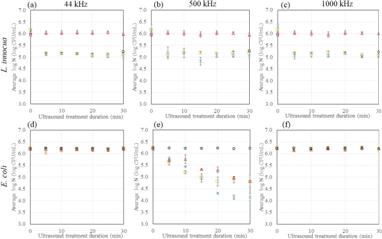The effect of ultrasound treatment in combination with nisin on the inactivation of Listeria innocua and Escherichia coli |
| |
| Affiliation: | 1. Department of Chemical and Process Engineering, University of Surrey, Guildford GU2 7XH, UK;2. Centre for 3D Models of Health and Disease, Division of Surgery and Interventional Science, University College London, London W1W 7TY, UK;3. School of Biosciences and Medicine, University of Surrey, Guildford GU2 7XH, UK;4. BioTeC+ Chemical and Biochemical Process Technology and Control, KU Leuven Campus Gent, Gent, Belgium |
| |
| Abstract: | 
Ultrasound, alone or in combination with natural antimicrobials, is a novel food processing technology of interest to replace traditional food decontamination methods, as it is milder than classical sterilisation (heat treatment) and maintains desirable sensory characteristics. However, ultrasound efficacy can be affected by food structure/composition, as well as the order in which combined treatments are applied. More specifically, treatments which target different cell components could result in enhanced inactivation if applied in the appropriate order. The microbial properties i.e. Gram positive/Gram negative can also impact the treatment efficacy.This work presents a systematic study of the combined effect of ultrasound and nisin on the inactivation of the bacteria Listeria innocua (Gram positive) and Escherichia coli (Gram negative), at a range of cavitation conditions (44, 500, 1000 kHz). The order of treatment application was varied, and the impact of system structure was also investigated by varying the concentration of Xanthan gum used to create the food model systems (0 – 0.5% w/v). Microbial inactivation kinetics were monitored, and advanced microscopy and flow cytometry techniques were utilised to quantify the impact of treatment on a cellular level.Ultrasound was shown to be effective against E. coli at 500 kHz only, with L. innocua demonstrating resistance to all frequencies studied. Enhanced inactivation of E. coli was observed for the combination of nisin and ultrasound at 500 kHz, but only when nisin was applied before ultrasound treatment. The system structure negatively impacted the inactivation efficacy. The combined effect of ultrasound and nisin on E. coli was attributed to short-lived destabilisation of the outer membrane as a result of sonication, allowing nisin to penetrate the cytoplasmic membrane and facilitate cell inactivation. |
| |
| Keywords: | Ultrasound Nisin Inactivation Hurdle technology |
| 本文献已被 ScienceDirect 等数据库收录! |
|

